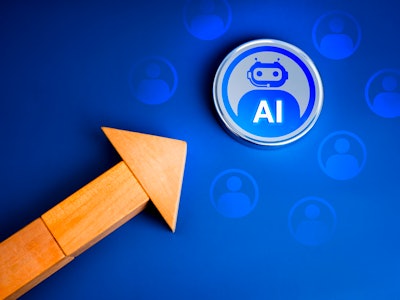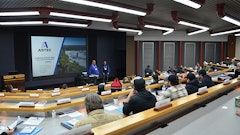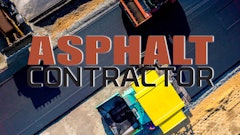
The skilled labor crisis isn’t on the horizon—it’s already here.
Millions of Baby Boomers with decades of hard-earned knowledge and experience in the field service industry are retiring and equipment dealers and rental businesses are feeling the effects: shrinking profits, rising costs, and a knowledge gap that threatens efficiency and customer satisfaction. This isn’t just about fewer workers—it’s about losing all the know-how that’s kept the world running for decades. That’s not something you can replace overnight.
Colloquially known as the “Silver Tsunami,” this mass exodus is already reshaping businesses. While these challenges are serious, OEMs, dealers and rental houses aren’t just standing by. Many are turning to AI to capture critical expertise before it’s lost, streamline operations, and help less-experienced workers perform at a higher level.
The Impact of the Skilled Labor Shortage on the Equipment Businesses
When new technicians have the right information at their fingertips, they can troubleshoot faster, avoid unnecessary downtime, and get the job done right the first time.
When a veteran tech clocks out from work for the last time, they take decades of experience with them — and most of it was never written down.
That’s not just a staffing problem. It’s a direct hit to efficiency, revenue, and the way work gets done. A recent survey found that just 57 percent of Baby Boomers admit they have passed on less than half of their knowledge even though they'll retire in a few years.
In the equipment rental business, time is money — and losing experienced technicians means service calls that used to take an hour can now stretch to half a day. Newer, less-experienced workers don’t have the same hands-on expertise to diagnose and fix issues quickly, leading to longer equipment downtime, delayed rentals, and frustrated customers. The ripple effect? Fewer completed jobs, higher costs from callbacks, and more money spent on training just to keep up.
“It’s tough finding people right now,” says Jose Protko, a 25-year industry veteran and insider, “A lot of our experienced guys are retiring, and the folks coming in just don’t have the same background. It used to be that the average tech in our industry had 15-20 years under their belt. Now it’s more like three to five. That changes everything—how fast businesses can respond, how much support do they need, even how confident we are sending them out on their own.”
That experience gap hits even harder now because the equipment is more complex than it used to be. Businesses need to ensure new hires can handle both the mechanical systems and the digital tools that come with them. Without the right training and resources, newer techs are left to figure things out on their own. And too often, that means turning to internet “experts” or outdated manuals—both of which can lead to costly mistakes.
A better solution? A structured knowledge-sharing system that makes sure critical expertise doesn’t walk out the door with retiring techs. When new technicians have the right information at their fingertips, they can troubleshoot faster, avoid unnecessary downtime, and get the job done right the first time.
That brings us to an even bigger concern — safety. With fewer experienced techs on the job, mistakes in the field become more common. And in the equipment industry, where safety is everything, one misstep can lead to costly accidents, damaged equipment, and a reputation that’s hard to repair.
It seems like the simple answer here would be to replace these retiring techs with other workers with equal, or almost equal, experience or have these experienced techs train the incoming workforce. Unfortunately, the number of people looking for a job in the trades is making it very hard to do that. According to the latest labor shortage trends and statistics, 75 percent of employers are struggling to fill these open positions. For rental businesses, this shortage can lead to slower response times and lost business opportunities.
“The industry is seeing fewer applicants for each job posting,” says Michael Suarez, Director of e-commerce at Forklift Parts and Equipment. “And new hires often need time to get up to speed. But customers don’t want to hear that—they just want the job done right and done fast so it puts a lot of pressure on the business. The industry will need to adopt more technology to deal with the labor shortage and keep customers happy. ”
AI-Powered Solutions to Help Equipment Rental Businesses
Dealerships and rental businesses also need to make the most of their technicians’ time, especially with a shrinking workforce.
These challenges are real, but equipment businesses aren’t out of options. AI is giving them a way to close the knowledge gap, keep operations running smoothly, and stay competitive — without waiting years for new techs to catch up.
One of these key use cases is predictive maintenance and asset management. With the help of AI, these businesses can stay ahead of equipment failures by predicting when maintenance is needed. They can also solve the issue of increased downtime and rising costs by scheduling proactive maintenance to avoid the need for expensive emergency repairs and extend the lifespan of rental equipment. This can be done by taking a look at how often equipment is being used, environmental data, and service history, all with the help of AI.
By keeping equipment in top shape, AI helps minimize downtime — but that’s only part of the equation. Dealerships and rental businesses also need to make the most of their technicians’ time, especially with a shrinking workforce.
AI can help by matching the right tech to the right job based on skills, location, and availability, ensuring faster service and fewer delays. Using AI to better schedule and dispatch technicians to job sites would also help save money and time to take care of last-minute service requests or emergencies.
However, efficiency isn’t just about getting the right tech to the right job — it’s about making sure they have the knowledge to do the work right. That’s where another major challenge comes in: tribal knowledge. Tribal knowledge is the unwritten, experience-based insights seasoned techs have built over the years, like troubleshooting techniques, maintenance shortcuts, and best practices that aren’t found in manuals. It also includes organizational knowledge like workflows, processes, and company-specific protocols that keep operations running smoothly.
AI is solving big problems in the equipment rental industry — but implementing it isn’t as simple as flipping a switch.
Luckily, AI makes it possible to capture tribal knowledge and put it directly into the hands of new technicians when they need it most. As new technicians are out in the field, they would have access to real-time, AI-assisted guidance. For example, a new technician working on a hydraulic issue could use an AI-powered tool to instantly pull up advice from experienced techs — past repair notes, how-to videos, and step-by-step guidance. Instead of calling for help or digging through manuals, they get the right answer on the spot, making the fix faster and more reliable.
AI is also transforming how dealerships and equipment rental businesses manage their fleets and resources — helping them save time, cut costs, and stay ahead of demand. For example, AI can predict equipment demand trends, which would help these businesses plan for the type and amount of equipment they should have available. In addition, AI can improve maintenance schedules to maximize equipment uptime and reduce unplanned downtime and emergency repairs, which threaten profitability.
For equipment businesses, AI isn’t just a tool — it’s quickly becoming the difference between falling behind and staying ahead.
Build vs. Buy: Should Equipment Businesses Develop Their Own AI?
AI is solving big problems in the equipment rental industry — but implementing it isn’t as simple as flipping a switch. Businesses have a choice: build a custom AI system, buy a pre-built solution, or find a middle ground. The right path depends on their budget, data, and how much control they need
Before making a decision, there are some questions to consider that could give a clear direction on how to move forward:
- Does your budget allow for the building of a custom AI platform?
- Does your company have enough clean data to train an AI model?
- What does your results timeline look like?
- How unique are your business needs?
- Does your business have people that are knowledgeable about building an AI platform?
If a business is looking to build their AI from scratch, they need to have the expertise and a sizeable investment in technology and infrastructure to make the whole process worth it. Sure, the first 80 percent of the building process is fun as you see a bit of progress each day, but it’s that last 20 percent — when the person that’ll be using the product takes center stage—that can be a real pain. If you’re lucky to reach and pass that milestone, make sure you keep focusing on one thing: solving the problem.
Buying a pre-built AI platform is the faster, cheaper route for an equipment business — it gets up and running quickly, so you see the benefits sooner. But there’s a trade-off. You’re working within the vendor’s limits, with fewer ways to tailor it to your business. If flexibility matters, that could be a dealbreaker.
A hybrid approach may make the most sense for those that want the best of both worlds. Businesses could start with a pre-built platform and then bring in custom models to handle specific workflows. Customization needs, budget, and long-term goals are things that have to be considered before making a decision.
This Isn't a Future Problem
[AI] won’t turn a rookie into a veteran overnight, but it can make sure they’ve got the right answers when it matters.
The skilled labor shortage isn’t some distant threat — it’s happening now, and equipment businesses are feeling the squeeze. Service times are dragging, costs are climbing, and every veteran tech who retires takes decades of experience with them. Those service calls that used to take an hour may now take half a day or longer because of newer, less-experienced workers, and loyal customers may be looking to take their business elsewhere after too many callbacks. What happens when the people that have been responsible for keeping our world running for decades are no longer around?
That’s where AI comes in. It won’t turn a rookie into a veteran overnight, but it can make sure they’ve got the right answers when it matters. It can keep businesses moving with smarter maintenance, faster dispatching, and real-time knowledge sharing — giving equipment companies the edge they need when experience is in short supply.
Adapt now, or fall behind.




















